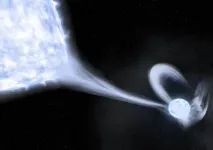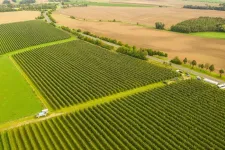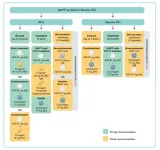(Press-News.org) DNA analysis of a 19th-century dog, paired with traditional knowledge acquired through interviews, have together provided new insights into the decline of Coast Salish “woolly dogs” – an extinct Indigenous dog once bred for its unique woolly coat. Dogs were introduced to the Americas at least 15,000 years ago and have been ubiquitous in Indigenous societies across the continents for thousands of years. Coast Salish peoples – a group of Indigenous societies that lived in the Salish Sea region of the Pacific Northwest (PNW) – kept several different types of dogs, including a special lineage of “woolly dogs” which had a thick woolen undercoat that was shorn for weaving blankets and textiles. However, due to increasing settler colonialism, the Coast Salish dog-wool weaving tradition declined throughout the 19th century; the Indigenous population of woolly dogs was lost. As a result, very little is known about these dogs, including their ancestry, the genetic underpinnings of their woolliness, and the factors that led to their ultimate disappearance. To address these questions, Audrey Lin and colleagues performed genomic and isotopic analyses on the only known pelt of an extinct Coast Salish dog, which belonged to a dog named Mutton that died in 1859. By comparing the genome sequence with other pre-Columbian and modern dog breeds, Lin et al. found that Mutton’s mitochondrial DNA was most similar to other pre-European contact lineages. According to the findings, Mutton’s genome showed limited introgression from European colonial dogs and, in general, lacked much genetic diversity, making Mutton the only known example of an Indigenous North American dog with dominant precolonial ancestry postdating the onset of European settlement in the area. Given the ubiquity of European ancestry present in many dog breeds at the time, the findings suggest that the Coast Salish peoples carefully and successfully maintained the genetic integrity of the woolly dog’s genetic lineage for a substantial period after first contact with colonizers. Moreover, the authors identified several candidate genetic variants linked to the dog’s distinctive woolly hair.
Working closely with Coast Salish Indigenous groups and incorporating these findings with traditional knowledge and historical records, Lin et al. were able to illustrate the cultural importance of the woolly dog and the drivers underlying their decline and extinction. Drivers included depopulation and forced migration of Indigenous peoples as well as colonial policies designed to disenfranchise and criminalize Coast Salish knowledge and cultural practices, including woolly dog husbandry. “The study from Lin et al. is exemplary for its engagement with local Indigenous communities,” writes Ludovic Orlando in a related Perspective. “Traditional Knowledge keepers were not just consulted for legal approval – a common concern for many studies – but their insights were recorded throughout the process as research material and directly embedded in the main text of the article.”
END
Ancient genomics and Indigenous Knowledge reveal history of Coast Salish “woolly dogs”
2023-12-14
ELSE PRESS RELEASES FROM THIS DATE:
Science’s 2023 Breakthrough of the Year: GLP-1 agonists show promise for obesity-associated health problems
2023-12-14
Science has named the development of glucagon like peptide-1 (GLP-1) agonists and this year’s discovery that these drugs can blunt obesity-associated health problems as its 2023 Breakthrough of The Year. Although obesity’s causes span genetic, physiological, environmental, and social factors, as a medical problem, obesity’s risks can be life-threatening – including heart disease, diabetes, arthritis, liver disease, and certain cancers. Drug treatments for obesity have had “a sorry past, one often intertwined with social pressure to lose weight and the widespread belief that excess weight reflects weak willpower,” writes ...
Using genomics to map illegal pangolin poaching from Africa to Asia
2023-12-14
Genomic analyses reveal illegal pangolin trafficking routes from origins in Africa to markets in Asia, researchers report. The approach offers new opportunities to monitor pangolin poaching in near real-time, allowing for targeted and more effective anti-trafficking measures. The illegal wildlife trade is a significant driver of global biodiversity loss. Of all the species poached and traded, the white-bellied pangolin (Phataginus tricuspis) is the world’s most trafficked mammal and is at risk of extinction. Pangolins are in high demand in Asia because their scales are believed, without scientific support, ...
Solar-powered clothes provide personal heating and cooling
2023-12-14
Combining a flexible solar cell with an electrocaloric device, researchers have created solar-powered clothing that allows the body to adapt dynamically to changes in ambient temperature, according to a new study. The new device could help guarantee the safety and comfort of the human body amid fluctuating environmental temperatures and even extend survivability in extreme environments, like those in outer space or other planets. Clothing is the most common way humans regulate their body temperature relative to the environment. However, it is normally focused on keeping an individual either warm or cool. The ability of clothing to ...
Reaching for the (invisible) stars
2023-12-14
Supernovae–stellar explosions as bright as an entire galaxy–have fascinated us since time immemorial. Yet, there are more hydrogen-poor supernovae than astrophysicists can explain. Now, a new Assistant Professor at the Institute of Science and Technology Austria (ISTA) has played a pivotal role in identifying the missing precursor star population. The results, now published in Science, go back to a conversation the involved professors had many years ago as junior scientists.
Some stars do not simply die down, but explode in a stellar blast that could outshine ...
How can Europe restore its nature?
2023-12-14
The ‘Nature Restoration Law’ (NRL) requires member states of the EU to implement restoration measures on at least 20 per cent of land and marine areas by 2030, and in all ecosystems in need of restoration by 2050. This includes specific targets to rewet peatlands and to increase pollinator populations. The NRL has already overcome various hurdles: most recently, it was approved by the EU Parliament’s Environment Committee, after delegations of the Parliament and the Council negotiated the final text.
But will the regulation really achieve its aims? The authors, including scientists leading large European projects on ...
Updated Canadian Cardiovascular Society Guidelines advise against routinely taking aspirin daily for primary prevention of heart attack or death but acknowledge there may be a role for some people
2023-12-14
Philadelphia, December 14, 2023 – The updated Canadian Cardiovascular Society (CCS)/Canadian Association of Interventional Cardiology (CAIC) antiplatelet therapy guidelines for primary and secondary prevention of atherosclerotic cardiovascular disease (ASCVD) provide recommendations based on the latest randomized evidence available in the literature. Updated by a panel of national experts, these new evidence-based guidelines appear in the Canadian Journal of Cardiology, published by Elsevier.
ASCVD, also known as ischemic heart disease (coronary artery ...
Rice study: AI provides more accurate analysis of prehistoric and modern animals, painting picture of ancient world
2023-12-14
A new Rice University study of the remains of prehistoric and modern African antelopes found that AI technology accurately identified animals more than 90% of the time compared to humans, who had much lower accuracy rates depending on the expert.
Composite images of teeth from five different antelope tribes analyzed and identified by artificial intelligence. Photo courtesy of Manuel Domínguez-Rodrigo.
Identifying these animals and their habits helps paint a broader picture of ancient ecosystems, and with the assistance of this new technology, it can be done with more speed and accuracy than previously done by paleontologists, ...
Working women feel unsupported by Christian congregations — even more progressive ones
2023-12-14
As church membership declines across the United States, a new study from Rice University’s Boniuk Institute for the Study and Advancement of Religious Tolerance finds that working women do not feel supported by their clergy and churches, regardless of whether they’re involved with a more conservative or liberal congregation.
“The Limits of Congregational Support for Working Women” is part of a larger study of faith at work funded by Lilly Endowment Inc. It ...
SNAP recipients may struggle to meet dietary goals, especially in food deserts
2023-12-14
The Supplemental Nutrition Assistance Program (SNAP) is the nation’s largest nutrition program, helping 41 million participants afford “nutritious food essential to health and well-being.”
But a new study from the University of Notre Dame found that SNAP participants in low-income households may not be able to meet the nutrition levels set by the Dietary Guidelines for Americans (DGA).
The case study set out to examine whether SNAP participants would be able to afford a healthy diet based on DGA’s recommended nutritional values. The DGA was created by the U.S. Departments of Agriculture and Health and Human ...
Researchers pave the way for next generation COVID-19 immunization strategies
2023-12-14
BOSTON – The global COVID-19 vaccination campaign saved an estimated 20 million lives. However, while current COVID-19 vaccines provide protection against developing severe disease, they do little to prevent infection and transmission.
Findings published in the journal Nature by physician-scientists at Beth Israel Deaconess Medical Center (BIDMC) and colleagues suggest that it may be possible to improve protection against COVID-19 by delivering the vaccine directly to the respiratory tract— the primary site of entry in SARS-CoV-2 infection.
“The ...



